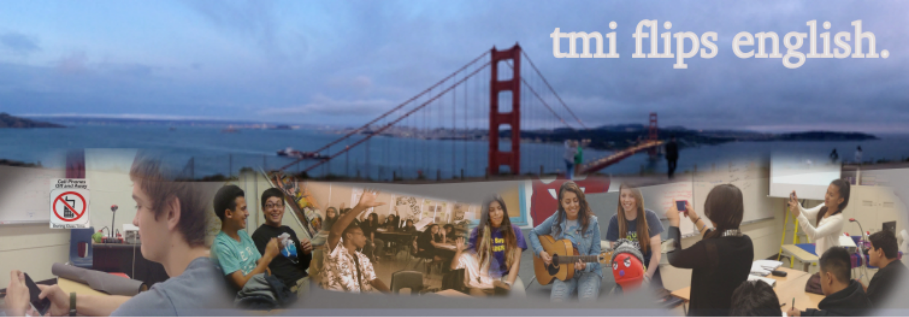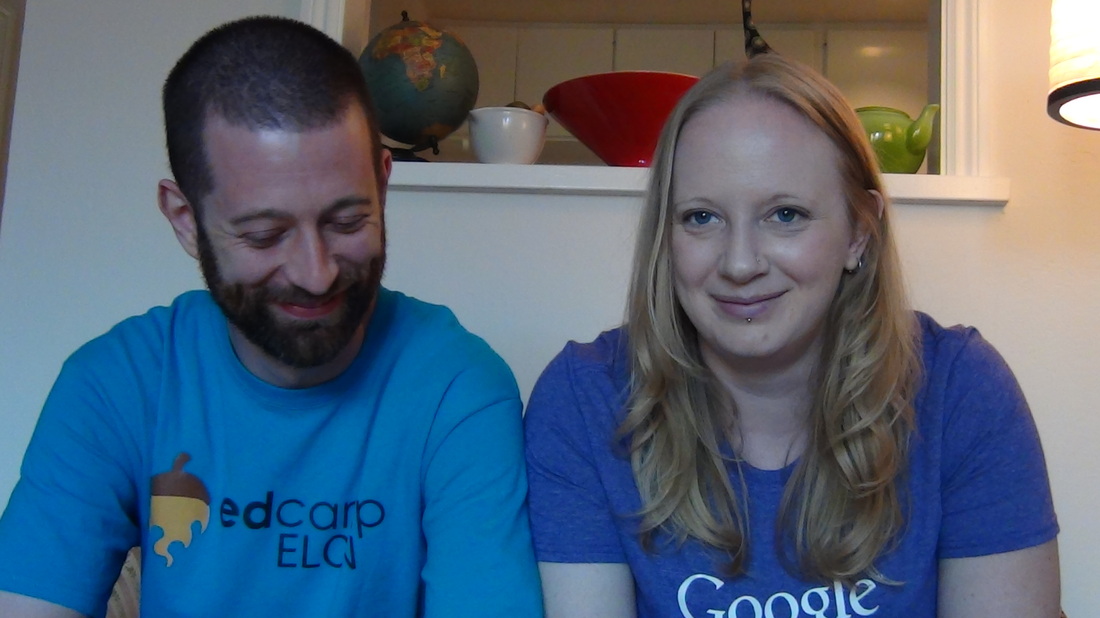But the reason why I think Twitter is one of the best things ever is not about any of those things. Here are two examples to prove my claim that Twitter is awesome:
1. When I got my first negative blog comment, my PLN on Twitter was there to reassure me, help me put it in perspective, and move on from it.
But more important than that...
2. Twitter is where I met my #flipclass partner in crime, Andrew Thomasson.
It's hard to believe that a week ago, I didn't know him at all. Now we've filmed and edited over an hour's worth of instruction for our series on writing a research paper, and we have even more ambitious plans in the works.
We "met" because we were following the #flipcon12 virtual action and were both looking for someone with whom we could partner to make skill videos for our students. After a really productive FaceTime session, we put together an outline of the videos/skills we needed to cover, and then on Saturday, we jumped right in...unaware that what we were doing was about to change everything.
We asked ourselves this main question: What skills or topics can we cover more effectively together than we could on our own?
The answer turned out to be the writing process, in its many iterations. So that's where we started.
The first video was great. The second and third (all shot in the same day, incidentally) were really great. The fourth is genius (well, Andrew's part is anyway...). It's so amazing to me that this is even happening at all, really. And now we're being asked to show others how to do what we're doing.
So here's my attempt to outline our process for building a partnership and planning/filming/editing the videos.
1. Technology
For this project, we are running Camtasia 2.2 for Mac on my 2010 MacBook Pro. We use that to record our screen, which always has our Google+ hangout open (both of us are on webcams). We also use the screenshare and Google Docs functions a lot. I just record the audio from my internal speakers (basically the built-in mic picks up my voice, along with whatever's coming out of the speakers).
Then I do the editing on Camtasia. Because of the video delay, I have learned to separate out the video and audio tracks, and match up the audio to the video. That results in a much better product. I also cut out the pauses and technical glitches. From about 20-25 minutes of raw footage, we get a 12-15 minute video. I then upload a beta version to YouTube (my channel is MsMorrisSLz), and Andrew reviews it. We send copious notes back and forth (usually in Twitter) and I fix, clean up, change, add, etc. whatever we decide. From there, I get it to a "final" version and then upload it to YouTube with a full description. Eventually, I'll add some annotations in YT so students can link back to other videos, just by clicking on the screen at a certain point.
2. Time
For every 25 minutes of recording, we probably spend 45-60 minutes planning, recording, and then debriefing. That's made a little more difficult by the time difference (he's EST and I'm PST) and our own alertness - I'm better at night, he's better in the morning. But we also spend hours planning, reflecting and editing over Twitter between filming sessions. This will obviously vary for anyone else, because all we can tell you is how long it takes us.
3. Planning
We start with a conversation - we decide on a rough outline of the skills we want to cover over the video series, and then try to break it into pieces. From there, I go through the Common Core Standards and make sure we are catching everything we should be (we're using the 11th-12th grade CCS because we both teach only 11th-12th) and Andrew plans the instructional sequence (he's the "teacher" in this series, and I get to learn from him!). Then we get on G+ and talk through a rough outline of what we'll cover in that video. We film, then quickly talk through next steps.
Then the editing begins. I'm constantly asking questions through the editing process, again through Twitter, to make sure I'm doing it right. Some of our best ideas have come out of these exchanges - in particular, the Batman theme we're running with in this series came out of a series of direct messages while I was editing video #2.
4. Teamwork and Style
Now, here's the place where I can't totally help you. I can tell you why Andrew and I work well together, although that's probably of limited help if you're trying to replicate what we're doing.
But here it is anyway:
--we have contrasting, but complementing personalities. I know MBTI isn't everyone's "thing" but in this case, it is interesting. I'm an INFJ, which means that I plan but in a chaotic way. I am idealistic and strongly introverted, although I play an extrovert in my classroom (and it drains the energy out of me like nothing other). Andrew is an INFP - which, coincidentally, is the same personality type that EVERY ONE of my close friends share. It just works, and it's pretty effortless.
--we have a similar (sarcastic) sense of humour. Don't underestimate the importance of that one.
--we have similar core beliefs about teaching, even if we came from very different pedagogical places in our career. We also have been teaching for roughly the same amount of time.
--we teach kids who are roughly the same age, same skill level, and same grade. This wouldn't work as well if I was making a video with a middle school teacher. Our teaching context is pretty similar, and that's important.
--we trust each other, and believe that the other always has the best possible intentions. In a process as intimate as team-teaching (which is what this is), if you don't trust your team-teacher, you may as well just give up (and I actually speak from experience on this one...I had one catastrophic team-teaching experience and swore never to do it again...ha). I told him really early on that it takes a lot to offend me. I want him to never feel like he can't say something because my feelings will get hurt. So we're blunt with each other, especially when something doesn't work.
--what we bring to the table in terms of the actual content of the video is different, but pushes both of us to be far more reflective and intentional in how we plan and present. We both see the beauty in the process of thinking aloud together, and letting it be a little messy. Life is messy, writing is messy, and teenagers are messy. We need to be willing to show that.
--we have a lot of fun. Making videos together is fun. We amuse each other with the fact that both of our lives are a nearly inexhaustible source of oddity (see? Told you I'd use that in the blog!). If we ever get to a point where it's not fun, we'll have to figure out how to make it fun again, because without that, this wouldn't work nearly as well.
**********
So how do you go about doing this for yourself?
First, find someone on Twitter or Edmodo who wants to try it (or post here - I know a lot of ELA teachers looking for partners in collaborative videos!). Then have a conversation over Google+ or FaceTime. You really MUST do it "face to face" instead of just over email or on the phone. The style and chemistry you have on video is important, so make sure it's something that you're both excited about and that you don't have to work hard to figure out and maintain.
Then decide on the scope of your project. Think small first - if you make big plans and the first video experience is horrible, you've wasted your time.
Next, hash out some ground rules/norms. Get to know each other a little bit. Talk about what you expect in terms of technology, planning, style, communication, etc. Don't spend every minute on G+ or FaceTime or Skype doing work. Hang out a little. That's what we do in our classrooms, so don't underestimate how important that is in this context.
Then just jump in. Some things you just have to do...talking about them for ages won't do as much for you as just diving in headlong and burying yourself in the task.
And don't be afraid to say that it's not working. No one wants to waste their time. You may have to find several people before someone "fits" with you. That's better than sinking hours into a video series that you won't even be able to use.
And finally, ask yourself this question: "What am I hoping another teacher will bring to this?" If you can't answer that question, don't do it.
If you have questions about the process, please ask! You can also find both of us on Twitter (@guster4lovers and @thomasson_engl). Andrew will probably be guest blogging here shortly, so watch out for that. And keep watching for the new videos as we announce them on Twitter and post them to YouTube. It's only going to get better, folks.
And it's already pretty awesome (or at least I think so).
[ETA: Check out our Thomasson and Morris Instruction page, with all the resources and information you could ever want.]
You know what else is awesome? This:
@guster4lovers@thomasson_engl @kadanielsWe would love to have you guys make a screencast on how you are making those vids together.
— Jonathan Bergmann (@jonbergmann) July 2, 2012
Here are the videos:
Oh, and PS, if you hate the videos, then it's all Andrew's fault.
(j/k!) :-)


 RSS Feed
RSS Feed
